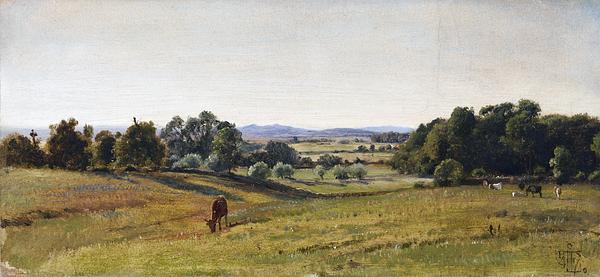By the middle of the nineteenth century, it had become a widespread practice for artists to paint small studies
en plein air, directly in front of their chosen subject. The method allowed for the best possible approximation to reality, the effect of daylight and the finer nuances of colour. For a painter like Johan Thomas Lundbye, the method was also about identifying and depicting the typical and universal aspects of the Danish landscape.
[1] To achieve this, he often went out into the countryside to find scenes of unspoilt nature which was not always easy to find. Still, he was occasionally lucky enough to find overgrown pastures where the signs of human intervention were less obvious.
In the summer of 1847, Lundbye went on a long sojourn which in June brought him to Kalundborg and Røsnæs, where his work included numerous studies of the beach and coast. The following month, Lundbye painted this open, gently hilly summer landscape with grazing cows as seen from the garden of the country estate Dortheaslyst.
[2] He had come to know the place quite well, having lived at Dortheaslyst for most of the month of June. In addition to landscapes, he also painted horses and other animals while staying there. There is much to suggest that he thrived at Dortheaslyst. In a letter to his friend Svend Grundtvig (1824–1883), Lundbye writes:
‘
My life here is as snug as a bug in a rug, and my host’s family is so amiable and cultivated, in the very best way, that I am never even tempted to doze off until between 6 and 7 in the morning.’
[3]Lundbye stayed with the Lunn family, whose head was Major Willars Knudsen Lunn (1775–1865) – the man who bred the Knabstrupper horse breed on the Knabstrup estate. There are many indications that this small landscape study used to belong to the family and was inherited through generations. Before it came into C.L. David’s possession, it belonged to his aunt, Agnes Lunn (1850–1941).
[4] It is likely that it was a gift from her to C.L. David, who appreciated Lundbye’s oil paintings as well as the drawings.
[5]
